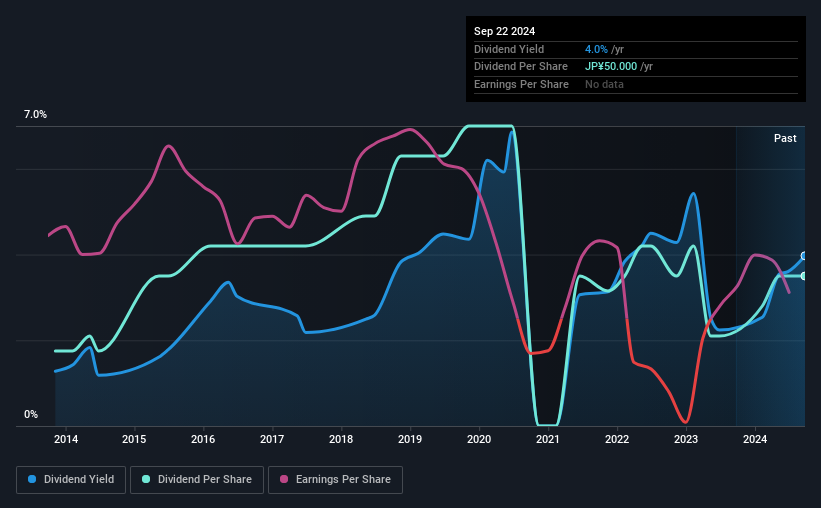Here's Why We're Wary Of Buying Kitagawa's (TSE:6317) For Its Upcoming Dividend

Kitagawa Corporation (TSE:6317) stock is about to trade ex-dividend in three days. The ex-dividend date is usually set to be one business day before the record date which is the cut-off date on which you must be present on the company's books as a shareholder in order to receive the dividend. The ex-dividend date is important as the process of settlement involves two full business days. So if you miss that date, you would not show up on the company's books on the record date. Thus, you can purchase Kitagawa's shares before the 27th of September in order to receive the dividend, which the company will pay on the 1st of January.
The company's next dividend payment will be JP¥25.00 per share, and in the last 12 months, the company paid a total of JP¥50.00 per share. Calculating the last year's worth of payments shows that Kitagawa has a trailing yield of 4.0% on the current share price of JP¥1259.00. Dividends are an important source of income to many shareholders, but the health of the business is crucial to maintaining those dividends. As a result, readers should always check whether Kitagawa has been able to grow its dividends, or if the dividend might be cut.
View our latest analysis for Kitagawa
Dividends are typically paid out of company income, so if a company pays out more than it earned, its dividend is usually at a higher risk of being cut. Kitagawa paid out 65% of its earnings to investors last year, a normal payout level for most businesses.
Click here to see how much of its profit Kitagawa paid out over the last 12 months.

Have Earnings And Dividends Been Growing?
Companies with falling earnings are riskier for dividend shareholders. If earnings fall far enough, the company could be forced to cut its dividend. Kitagawa's earnings per share have plummeted approximately 32% a year over the previous five years.
Another key way to measure a company's dividend prospects is by measuring its historical rate of dividend growth. Kitagawa has delivered an average of 7.2% per year annual increase in its dividend, based on the past 10 years of dividend payments. That's interesting, but the combination of a growing dividend despite declining earnings can typically only be achieved by paying out more of the company's profits. This can be valuable for shareholders, but it can't go on forever.
To Sum It Up
Is Kitagawa worth buying for its dividend? Earnings per share have been declining and the company is paying out more than half its profits to shareholders; not an enticing combination. In sum this is a middling combination, and we find it hard to get excited about the company from a dividend perspective.
If you're not too concerned about Kitagawa's ability to pay dividends, you should still be mindful of some of the other risks that this business faces. To that end, you should learn about the 4 warning signs we've spotted with Kitagawa (including 1 which is a bit concerning).
Generally, we wouldn't recommend just buying the first dividend stock you see. Here's a curated list of interesting stocks that are strong dividend payers.
Valuation is complex, but we're here to simplify it.
Discover if Kitagawa might be undervalued or overvalued with our detailed analysis, featuring fair value estimates, potential risks, dividends, insider trades, and its financial condition.
Access Free AnalysisHave feedback on this article? Concerned about the content? Get in touch with us directly. Alternatively, email editorial-team (at) simplywallst.com.
This article by Simply Wall St is general in nature. We provide commentary based on historical data and analyst forecasts only using an unbiased methodology and our articles are not intended to be financial advice. It does not constitute a recommendation to buy or sell any stock, and does not take account of your objectives, or your financial situation. We aim to bring you long-term focused analysis driven by fundamental data. Note that our analysis may not factor in the latest price-sensitive company announcements or qualitative material. Simply Wall St has no position in any stocks mentioned.
About TSE:6317
Kitagawa
Manufactures and supplies synthetic metals, machine tool accessories, and industrial machinery in Japan and internationally.
Excellent balance sheet established dividend payer.


